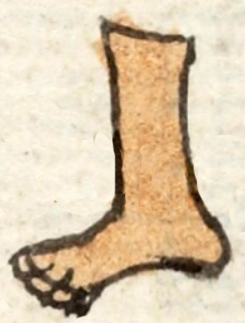xo (Mdz2r)
This element has been carved from the compound sign for the place name, Xomimitl. It is a human foot (-xo-) in profile, with the toes on our left. It is painted a terracotta flesh tone. It is unadorned and without a shoe.
Stephanie Wood
The glyph has the phonetic reading of -xo-, which means "foot" in many compounds, such as: xo-pilli = toe, and xo-cpalli or ic-xo-polli, two words for the sole of the foot. Sometimes, however, -xo- can also mean green. It is important to recognize here, too, that footprints can have a phonetic value of "pan" (on) or the sounds "o" or "ot," when coming from otli, road or pathway, given that footprints on cartographic paintings typically refer to a road or path. The foot can also be symbolically representative of the verb pano, to cross or cross over.
Stephanie Wood
c. 1541, or by 1553 at the latest
Stephanie Wood

xo-, an element with the sense of foot in compounds, https://nahuatl.wired-humanities.org/content/xo
xopil(li), the toes of the foot, https://nahuatl.wired-humanities.org/content/xopilli
icxopol(li), the sole of the foot, https://nahuatl.wired-humanities.org/content/icxopolli
xocpal(li), the sole of the foot, https://nahuatl.wired-humanities.org/content/xocpalli
-pan (locative suffix), https://nahuatl.wired-humanities.org/content/pan
pano, to cross or cross over, https://nahuatl.wired-humanities.org/content/pano
foot
el pie
Stephanie Wood
Codex Mendoza, folio 2 recto, https://codicemendoza.inah.gob.mx/inicio.php?lang=english
The Bodleian Libraries, University of Oxford, hold the original manuscript, the MS. Arch. Selden. A. 1. This image is published here under the UK Creative Commons, “Attribution-NonCommercial-ShareAlike 3.0 License” (CC-BY-NC-SA 3.0).

